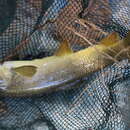mk
имиња во трошки


Capoeta damascina, the Levantine scraper or Mesopotamian barb, is a species of cyprinid fish from the Near East region. It is reported from Iraq, Israel, Jordan, Lebanon, Syria, Iran and Turkey.[1][3]
It is a bottom feeding fish, up to 50 cm (1.6 ft) long but typically about 30 cm (1 ft), and it lives in lakes as well as both fast and slow-moving streams, and both in clear and muddy waters. It is said to have tasteless flesh and toxic eggs.[2] It has been recorded hybridising with Carasobarbus canis but these hybrids are sterile.[4]
Capoeta damascina, the Levantine scraper or Mesopotamian barb, is a species of cyprinid fish from the Near East region. It is reported from Iraq, Israel, Jordan, Lebanon, Syria, Iran and Turkey.
It is a bottom feeding fish, up to 50 cm (1.6 ft) long but typically about 30 cm (1 ft), and it lives in lakes as well as both fast and slow-moving streams, and both in clear and muddy waters. It is said to have tasteless flesh and toxic eggs. It has been recorded hybridising with Carasobarbus canis but these hybrids are sterile.
 Carasobarbus canis x Capoeta damascina - ZooKeys-339-001-g028
Carasobarbus canis x Capoeta damascina - ZooKeys-339-001-g028